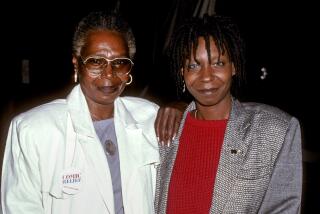Wild West Is Alive in West Germany
The Old West of American Indians and cowboys is riding as never before in this German health spa near the Baltic Sea.
Apache Chief Winnetou has been the fantasy hero of summertime at the Bad Segeberg spa for 37 years, and now he is joined by real-life Indians representing tribes in the United States.
Reuben Snake, chief of the Winnebagos in Nebraska, helped to set the stage for what is happening here this summer. Former President Gerald Ford, an Omaha native, has sent a letter of support. The Gordon Bird family is representing Minnesota Indians.
Near Luebeck
How did it all come about? At Bad Segeberg, a 20-minute drive from the medieval spires of Luebeck, the story began with the tales of a writer who has often been called Germany’s Zane Grey.
Karl May (pronounced My) lived from 1842 to 1912. He wrote more than 70 books, imaginative adventures from the Wild West of 19th-Century America to Africa and the near and Far East. Most successful of his many best sellers were three about the Apache Indian chief he named Winnetou; each book sold more than 3 million copies.
As one reviewer wrote, Winnetou came to symbolize “courage and bravery, loyalty and friendship, within an aura of adventure and life far away. . . . He helped us to understand another culture. Grandparents gave copies of his books to their grandchildren.”
Based on Novels
Nearly four decades ago, Bad Segeberg began presenting a play based on the Winnetou novels for the summer entertainment of families who came to the spa for vacations. Other attractions are the hot baths and curative air, water sports on the lake and hiking trails through the countryside.
The outdoor theater today seats 10,000, and the play has been developed to include cowboys and Indians on horseback, riding their horses with a thunder of hoofbeats.
The new reality has been introduced by Guenther Beckman, a Lincoln, Neb., businessman who was born near Bad Segeberg and emigrated to Nebraska in 1956. After building his construction and lumber company into a firm that became Beckman International, he had the time and the means to add another dimension to summer in Bad Segeberg.
Beckman knew the stories of May from his boyhood. In his adopted homeland he read the works of the late Nebraska Poet Laureate John G. Neihardt, who wrote about Black Elk, the Oglala Sioux holy man.
Beckman and his wife Carol began to envision a cultural exchange program that would build tourism and economic ties between the United States and Germany and bring to American travelers a greater appreciation of what the Indian culture means to their own country.
Cultural Exchange Program
Last summer the Beckmans took Neihardt’s daughter and Winnebago Chief Reuben Snake to the annual Karl May Theater Festival in Bad Segeberg. The University of Kiel, on the Baltic Sea north of Bad Segeberg, expressed interest in making the story of the American Indian part of its curriculum.
With the Beckmans’ cooperation, the support and financing quickly came together for a Nebraska Haus and Apache cultural center at Bad Segeberg. The two-story, frontier-style building in a setting of Indian tepees and artifacts was opened and dedicated May 23 in readiness for the annual Karl May Theater Festival, which began June 27 and continues until Aug. 30.
The cost of the new development was about $150,000.
Guenther and Carol Beckman are spending the summer overseeing the Nebraska Haus and museum. The Bird Indian family from Minnesota presents stories and dances of their people daily. Plans are being made for similar visits by other American Indian representatives next summer.
“Travel,” says Beckman, “can open so many doors for bringing all peoples closer together.”
For more information about Bad Segeberg, contact the German National Tourist Office, 444 S. Flower St., Suite 2230, Los Angeles 90071, phone (213) 680-7332.
More to Read
Sign up for our Book Club newsletter
Get the latest news, events and more from the Los Angeles Times Book Club, and help us get L.A. reading and talking.
You may occasionally receive promotional content from the Los Angeles Times.






